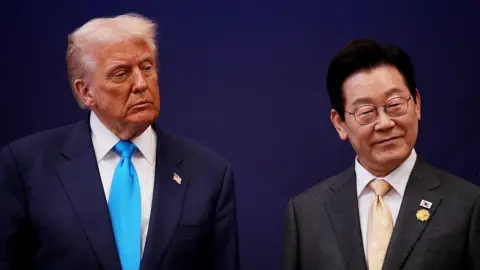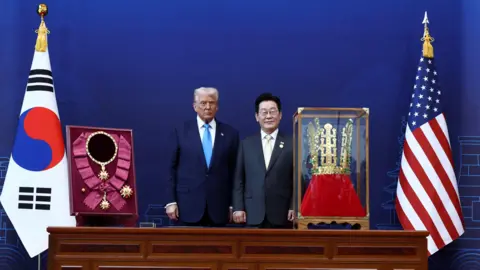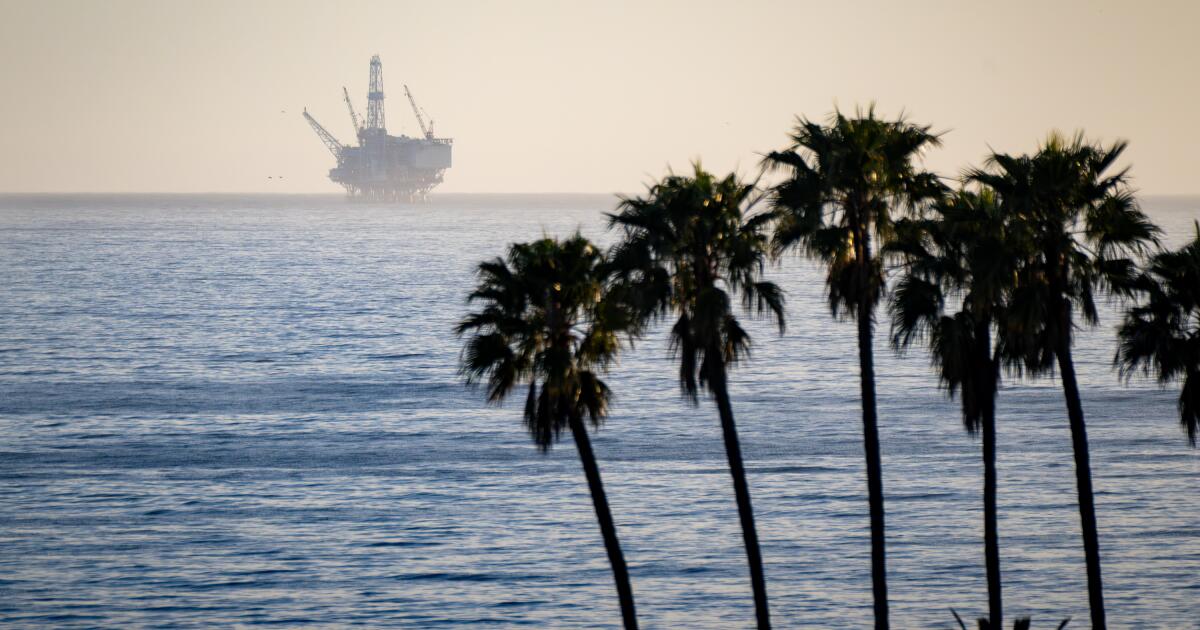S Korea announces lowering of some tariffs as part of new US trade deal
Koh Ewe,Singapore and
Kathryn Armstrong,London
 Getty Images
Getty ImagesThe US and South Korea have reached a broad trade deal, both countries have said following talks between their leaders.
South Korea’s presidential aide, Kim Yong-beom, said the two sides will keep reciprocal tariffs at 15%, as was agreed earlier this year, but that the taxes on car and car parts would be lowered.
South Korea will also invest $350bn in the US, including $200bn in cash investment and $150bn in shipbuilding, Kim said.
US President Donald Trump, who is currently on a week-long trip in Asia, said the deal was “pretty much finalised” at a dinner following the discussions, which lasted almost two hours. He did not give further details.
“We had a tremendous meeting today with South Korea”, Trump said, adding that “a lot was determined”.
“We discussed some other things to do with national security et cetera. And I think we came to a conclusion on a lot of very important items.”
Both sides had played down the prospect of a breakthrough ahead of Wednesday’s talks – disappointing many in South Korea’s electronics, chip and auto industries, which had been hoping for some clarity amidst the tariff chaos.
Trump had slapped a tariff rate on Seoul of 25% earlier this year – which South Korean President Lee Jae Myung managed to negotiate down to 15%, after Seoul said it would invest $350bn in the US and buy $100bn worth of liquified natural gas.
But the White House later increase its demands as part of the trade talks, with Trump pushing for cash investments in the US.
Both countries have historically been key allies – but tensions spiked after hundreds of South Koreans were detained in an immigration raid in the US last month.
Trump will next meet his Chinese counterpart Xi Jinping in on Thursday on the sidelines of a summit of the Asia-Pacific Economic Cooperation (Apec) which is taking place in Gyeongju.
China’s foreign ministry has confirmed the meeting, which will take place in the city of Busan on Thursday, a short flight away from Gyeongju.
The US president said on Wednesday that he was “looking forward” to the meeting.
“We’ve been talking a lot over the last month and I think we’re going to have something that’s gonna be very, very satisfactory to China and to us.”
This will be the two leaders’ first face to face meeting since Trump assumed office in 2025 and imposed tariffs on every country in the world.
Addressing a group of CEOs in Gyeongju on Wednesday, Trump said that he believes the US is “going to have a deal” with China and it will be “a good deal for both”.
He also praised the Apec countries for making the global trading system, which he said had been “broken” and “in urgent need of reform”, fairer.
“Economic security is national security,” Trump says. “That’s for South Korea, that’s for any country.”
Golden crowns and grand orders
Ahead of Wednesday’s talks with President Lee, Trump had been greeted by an honour guard and gifts that included a golden crown.
“I’d like to wear it right now,” Trump had said of the crown.
He also received the Grand Order of Mugunghwa, South Korea’s highest decoration.
He’s the first US president to receive the award, which was given “in recognition of his contribution to peace on the Korean Peninsula”, the South Korean presidential office said.
Both leaders took part in a working lunch – which was followed by a private meeting in the afternoon.
 Reuters
ReutersTrump’s arrival in South Korea had been preceded by North Korea test-firing surface-to-air cruise missiles.
The US president had expressed interest in meeting North Korean leader Kim Jong Un but noted on Wednesday that his team had been unable to arrange this during his trip.
Noting the long-standing tensions between North and South Korea, Trump said “we will see what we can do to get that all straightened out”.
And outside the summit venue where both leaders were meeting, a small anti-Trump group of protesters gathered on Wednesday afternoon, with some shouting anti-Trump slogans. Police could be seen forcibly dispersing the crowd and arresting some people.
However, hundreds more attended a pro-Trump rally – including those who shouted anti-Chinese rhetoric – also took places close to the summit venue.
Anti-Chinese sentiment in South Korea has also grown steadily in recent years. Chinese interference became a common trope in conspiracy theories about former South Korean president Yoon Suk Yeol.
 BBC/Leehyun Choi
BBC/Leehyun ChoiDuring his trip to Japan on Tuesday, the US president signed an agreement on rare earth minerals with Tokyo, as well as a document heralding a new “golden age” of US-Japan relations. This reiterated the commitment of the two countries to implement deals struck earlier, including the 15% tariff deal negotiated earlier this year.
Prior to that, he attended a gathering of South East Asian leaders, known as Asean, in Malaysia. There he presided over a “peace deal” between Thailand and Cambodia, whose longstanding border dispute erupted into open conflict in July.
With additional reporting by Laura Bicker, China Correspondent and Suranjana Tewari, Asia Business Correspondent


